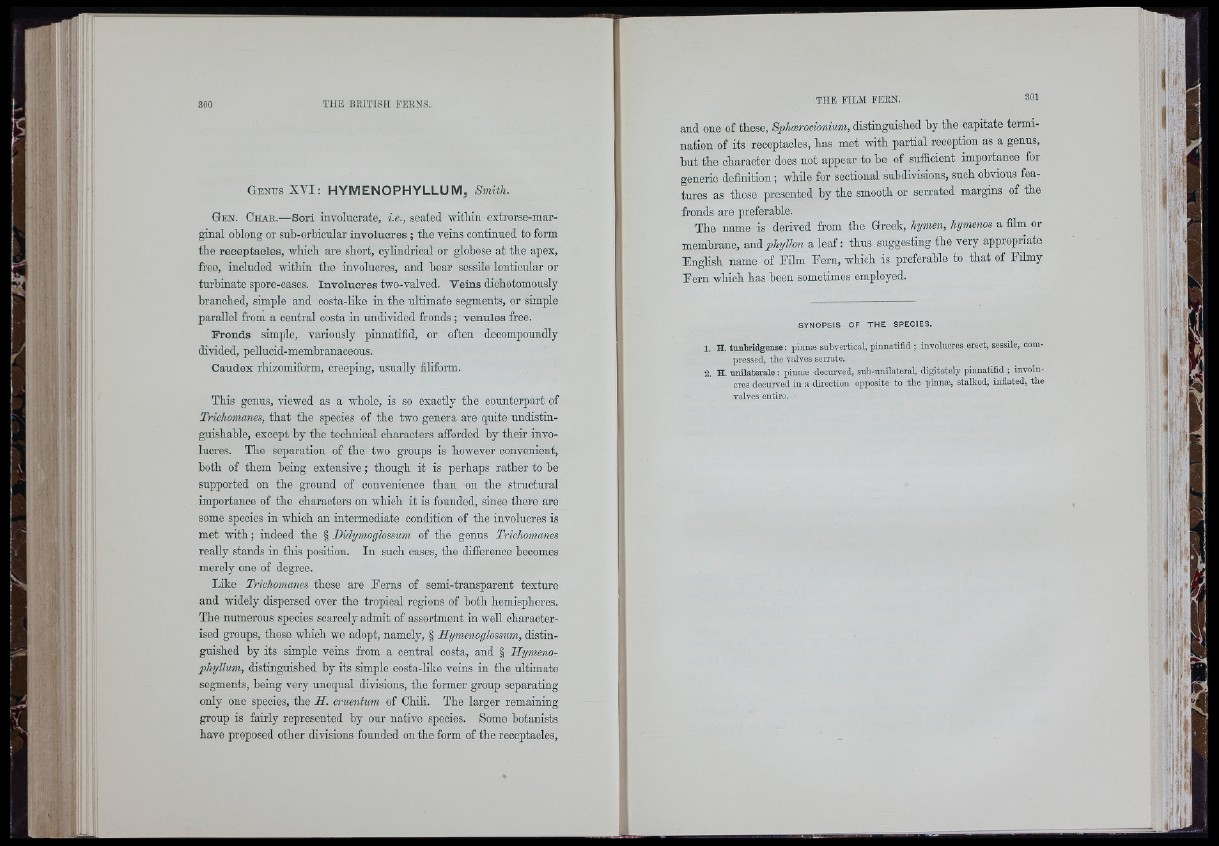
f ' ñ
i ti'
Mi Y
• :f f ■
l i ; Iff
Genus XVI: H Y M E N O P H Y L L U M , Smith.
Gen. Chak.—Sori involúcrate, i.e., seated 'witliin oxtrorse-mar-
ginal oblong or sub-orbioular involucres ; tbe voins continued to form
tbe receptacles, wbiob are sbort, cylindrical or globose at tbe apex,
free, included within the involucres, and bear sessile lenticular or
turbinate spore-oases. Involucres two-valved. Veins diohotomously
branched, simple and costa-üke in the ultimate segments, or simple
parallel from a central oosta in undivided fronds; venules free.
Fronds simple, variously pinnatifid, or often deoompoundly
divided, pelluoid-memhranaoeous.
Caudex rhizomiform, creeping, usually filiform.
This genus, viewed as a whole, is so exactly the counterpart of
Trichomanes, that the species of the two genera are quite undistinguishable,
except by the technical characters afforded by their involucres.
The separation of the two groups is however convenient,
both of them being extensive ; though it is perhaps rather to be
supported on the ground of convenience than on the structural
importance of the characters on which it is founded, since there are
some species in which an intermediate condition of the involucres is
met with; indeed the § Bidymoglossum of the genus Trichomanes
really stands in this position. In such cases, the difference becomes
merely one of degree.
Like Trichomanes these are Ferns of semi-transparent texture
and widely dispersed over the tropical regions of both hemispheres.
The numerous species soaroely admit of assortment in well characterised
groups, those which we adopt, namely, § Hymenoglossim, distinguished
by its simple veins from a central costa, and § Hymeno-
phyllum, distinguished by its simple costa-like veins in the ultimate
segments, being very unequal divisions, the former group separating
only one species, the H. cruentum of Chih. The larger remaining
group is fairly represented hy our native species. Some botanists
have proposed other divisions founded on the form of the receptacles.
and one of these, Sphceroeionium, distinguished hy the capitate termination
of its receptacles, has met with partial reception as a genus,
hut the character does not appear to he of sufficient importance for
generic definition ; while for sectional subdivisions, such obvious features
as those presented by the smooth or serrated margins of the
fronds are preferable.
The name is derived from the Greek, hymen, hymenos a film or
membrane, and phyllon a leaf: thus suggesting the very appropriate
English name of Film Fern, which is preferable to that of Filmy
Fern which has been sometimes employed.
SYNOPSIS OF TH E SPECIES.
1. H. timbridgense; piimæ suljvertical, pinnatifid ; involucres erect, sessile, compressed,
tlie valves serrate.
2. H, tmUaterale ; pinnæ decurved, snb-iinilateral, digitately pinnatifid ; involucres
decurved in a direction opposite to tlie pinnæ, stalked, inflated, tlie
yalves entire.
Yti-
( I
‘ ' L' «
fiM
If!
* Í
m
( l i i
I
il
¿M'